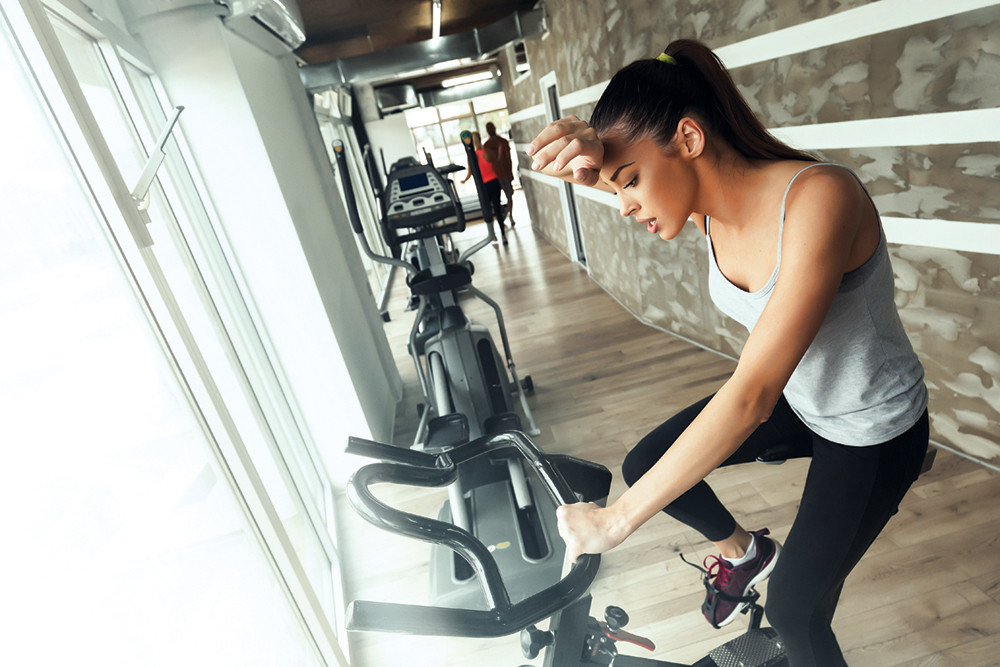
I know that at some point in our lives we have had someone telling us to sit up or stand straight, or to correct our slouch and slump. For me, it was not just a casual reminder but posture correction came as a strict instruction and lesson. I was made to realise the importance of good posture early on. As a child learning karate, I recall my Sensei repeatedly stress on the importance of good posture which he said would ensure balance, focus and power. The same reminder also came from my Yoga Guru who stressed on proper posture to bridge the gross and the subtle states of the body for a complete experience. And later my Master Trainer cleared my understanding further about the importance of proper posture. He said that every exercise movement will not be able to accomplish its objective of effective muscle stimulation without proper form/technique of which correct posture is the foundation.
Our posture determines how we handle and manage our body’s structure at any phase - standing, sitting, lying down and moving. Posture is maintained mainly by the muscles and non-contractile tissues such as ligaments, joint capsule, etc. Proper posture is indicated by balance in muscles (flexibility, length and strength) and proper alignment of the structure. Good posture allows you to place the least possible stresson your body to create efficient biomechanics and also prevents unnecessary fatigues, pains and injuries. Similarly bad posture negatively affects the whole body, both short and long term, from sore muscles to vertebral misalignment, spinal deviation, blood vessel constriction, nerve pinching, etc. Surprisingly and sadlymost people are unaware of the extent of its ill effects, and tend to further worsen their health condition. For example many of us may not know thata rounded upper back constricts the chest cage making it impossible to breathe fully resulting in oxygen deficiency. Or the swayback, where the intestines press against the floor of the abdominal cavity instead of being held in place. Most people with postural deviations are usually unaware of their posture and its resulting consequences.
One of my clients told me that he sits for at least six hours at a stretch every day. He was surprised and reluctant to understand initially that the pressures on the vertebral discs are higher when sitting than when standing or lying down. His logic was that he suffered morefrom back pain while standing and the pain was eased when he sat. I understood his dilemma and confusion with the new information and explained thatdistinction must be made between the back muscles and the vertebral discs. The pain that you feel while standing for long periods is muscle related due to tired lower back muscles. We relax our supporting muscles while sitting which causes a majority of body weight to load onto our discs. Secondly, increased pressure on the discs in and of itself does not necessarily cause immediate pain. Thus people are often unaware of this pressure which in the long term can cause deformationin the spinal discs and consequential challenges.
 I have noticed that people are conscious about their form while exercisingyet fail to extend the practice outside the gym. Your gym work only comprises about 20 percent of all daily activity, and the 80 percent of your bad postural state is bound to create negative repercussion in your body. Because sitting is inevitable for most people at desk jobs, the best advice is to limit time spent sitting at a stretch as much as possible. Spinal disorders are preventable and aches and pains are avoidable. You only have to be aware of your body. Take breaks every 20-30 minutes to stretch, walk around when sitting for extended hours of time. Chairs with lumbar support and arm rest always help as does having a good quality mattress to sleep. Incorporate exercise into your life even if it is 20 minutes of walking, stretching and deep breathing to relax your body.
If you are already suffering from back aches, shoulder and neck stiffness, numbing or tingling sensation in the legs and arms, please see a professional to analyse and diagnose your condition to eliminate further damage through proper treatment. Do note that a little pain here and there is not okay. It can lead to chronic states and even immobilise you from your daily activities.
So what is proper posture put simply? Proper posture is when you keep bones and joints aligned so that muscles are used properly and this helps decrease the abnormal wearing of your joint surfaces. Stand sideways in front of a full length mirror. If you draw an invisible straight line through your body, do your ear, shoulder, hip and ankle joint align together? If it does, you have the right standing posture. If not, you need to consciously correct your posture. Seek help if necessary. Importantly, maintaining the natural curvature of the spine without stiffening and straining your muscles is at the core of having a good posture. That applies to all movements and while at rest.
To ensure that your body is properly aligned, you must avoid or ensure caution in the following positions and movements: having a slumped, head forward posture; bending forward from the waist; twisting the spine to the point of strain; twisting the trunk and bending forward; anything that requires you to reach far and lose your balance, etc. Proper body alignment not only helps prevent pain and injury, it adds to your confidence. Improving your posture will take time and effort, but the benefits are worth it.
I have noticed that people are conscious about their form while exercisingyet fail to extend the practice outside the gym. Your gym work only comprises about 20 percent of all daily activity, and the 80 percent of your bad postural state is bound to create negative repercussion in your body. Because sitting is inevitable for most people at desk jobs, the best advice is to limit time spent sitting at a stretch as much as possible. Spinal disorders are preventable and aches and pains are avoidable. You only have to be aware of your body. Take breaks every 20-30 minutes to stretch, walk around when sitting for extended hours of time. Chairs with lumbar support and arm rest always help as does having a good quality mattress to sleep. Incorporate exercise into your life even if it is 20 minutes of walking, stretching and deep breathing to relax your body.
If you are already suffering from back aches, shoulder and neck stiffness, numbing or tingling sensation in the legs and arms, please see a professional to analyse and diagnose your condition to eliminate further damage through proper treatment. Do note that a little pain here and there is not okay. It can lead to chronic states and even immobilise you from your daily activities.
So what is proper posture put simply? Proper posture is when you keep bones and joints aligned so that muscles are used properly and this helps decrease the abnormal wearing of your joint surfaces. Stand sideways in front of a full length mirror. If you draw an invisible straight line through your body, do your ear, shoulder, hip and ankle joint align together? If it does, you have the right standing posture. If not, you need to consciously correct your posture. Seek help if necessary. Importantly, maintaining the natural curvature of the spine without stiffening and straining your muscles is at the core of having a good posture. That applies to all movements and while at rest.
To ensure that your body is properly aligned, you must avoid or ensure caution in the following positions and movements: having a slumped, head forward posture; bending forward from the waist; twisting the spine to the point of strain; twisting the trunk and bending forward; anything that requires you to reach far and lose your balance, etc. Proper body alignment not only helps prevent pain and injury, it adds to your confidence. Improving your posture will take time and effort, but the benefits are worth it.
Sandesh Palungwa Limbu, Certified professional fitness instructor, founder of RAGE Fitness, and specialises in mixed martial arts.
 I have noticed that people are conscious about their form while exercisingyet fail to extend the practice outside the gym. Your gym work only comprises about 20 percent of all daily activity, and the 80 percent of your bad postural state is bound to create negative repercussion in your body. Because sitting is inevitable for most people at desk jobs, the best advice is to limit time spent sitting at a stretch as much as possible. Spinal disorders are preventable and aches and pains are avoidable. You only have to be aware of your body. Take breaks every 20-30 minutes to stretch, walk around when sitting for extended hours of time. Chairs with lumbar support and arm rest always help as does having a good quality mattress to sleep. Incorporate exercise into your life even if it is 20 minutes of walking, stretching and deep breathing to relax your body.
If you are already suffering from back aches, shoulder and neck stiffness, numbing or tingling sensation in the legs and arms, please see a professional to analyse and diagnose your condition to eliminate further damage through proper treatment. Do note that a little pain here and there is not okay. It can lead to chronic states and even immobilise you from your daily activities.
So what is proper posture put simply? Proper posture is when you keep bones and joints aligned so that muscles are used properly and this helps decrease the abnormal wearing of your joint surfaces. Stand sideways in front of a full length mirror. If you draw an invisible straight line through your body, do your ear, shoulder, hip and ankle joint align together? If it does, you have the right standing posture. If not, you need to consciously correct your posture. Seek help if necessary. Importantly, maintaining the natural curvature of the spine without stiffening and straining your muscles is at the core of having a good posture. That applies to all movements and while at rest.
To ensure that your body is properly aligned, you must avoid or ensure caution in the following positions and movements: having a slumped, head forward posture; bending forward from the waist; twisting the spine to the point of strain; twisting the trunk and bending forward; anything that requires you to reach far and lose your balance, etc. Proper body alignment not only helps prevent pain and injury, it adds to your confidence. Improving your posture will take time and effort, but the benefits are worth it.
I have noticed that people are conscious about their form while exercisingyet fail to extend the practice outside the gym. Your gym work only comprises about 20 percent of all daily activity, and the 80 percent of your bad postural state is bound to create negative repercussion in your body. Because sitting is inevitable for most people at desk jobs, the best advice is to limit time spent sitting at a stretch as much as possible. Spinal disorders are preventable and aches and pains are avoidable. You only have to be aware of your body. Take breaks every 20-30 minutes to stretch, walk around when sitting for extended hours of time. Chairs with lumbar support and arm rest always help as does having a good quality mattress to sleep. Incorporate exercise into your life even if it is 20 minutes of walking, stretching and deep breathing to relax your body.
If you are already suffering from back aches, shoulder and neck stiffness, numbing or tingling sensation in the legs and arms, please see a professional to analyse and diagnose your condition to eliminate further damage through proper treatment. Do note that a little pain here and there is not okay. It can lead to chronic states and even immobilise you from your daily activities.
So what is proper posture put simply? Proper posture is when you keep bones and joints aligned so that muscles are used properly and this helps decrease the abnormal wearing of your joint surfaces. Stand sideways in front of a full length mirror. If you draw an invisible straight line through your body, do your ear, shoulder, hip and ankle joint align together? If it does, you have the right standing posture. If not, you need to consciously correct your posture. Seek help if necessary. Importantly, maintaining the natural curvature of the spine without stiffening and straining your muscles is at the core of having a good posture. That applies to all movements and while at rest.
To ensure that your body is properly aligned, you must avoid or ensure caution in the following positions and movements: having a slumped, head forward posture; bending forward from the waist; twisting the spine to the point of strain; twisting the trunk and bending forward; anything that requires you to reach far and lose your balance, etc. Proper body alignment not only helps prevent pain and injury, it adds to your confidence. Improving your posture will take time and effort, but the benefits are worth it.
Sandesh Palungwa Limbu, Certified professional fitness instructor, founder of RAGE Fitness, and specialises in mixed martial arts.
Published Date: October 17, 2017, 12:00 am
Post Comment
E-Magazine
RELATED Get Fit





